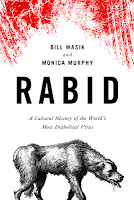
Today, more than 55,000 people still die from rabies each year, most in Africa and Asia, but the disease holds far less sway over popular and medical imaginations. Not until the 1880s did Louis Pasteur’s research team develop a vaccine that lifted what had been a death sentence for anyone infected. A 19th century quack doctor suggested that dogs spontaneously generated rabies if they didn’t have enough sex - a concept that took off in 1830s England and seriously set back attempts to develop modern treatments. Pliny the Elder thought a maggot from any dead canine, inserted into a wound, would cure the disease. One blue-blooded lady, they report, contracted rabies and died after her infected lapdog licked her on the chin. But they excel at chronicling the bizarre, especially when it comes to rabid links with man’s best friend.

Wasik and Murphy chronicle more than two millennia of myths and discoveries about rabies and the animals that transmit it, including dogs, bats and raccoons.Wasik and Murphy don’t go into the science of rabies in depth. A smart, unsettling, and strangely stirring piece of work." "In this keen and exceptionally well-written book, rife with surprises, narrative suspense and a steady flow of expansive insights, 'the world's most diabolical virus' conquers the unsuspecting reader's imaginative nervous system.


From Greek myths to zombie flicks, from the laboratory heroics of Louis Pasteur to the contemporary search for a lifesaving treatment, Rabid is a fresh and often wildly entertaining look at one of humankind's oldest and most fearsome foes. In this critically acclaimed exploration, journalist Bill Wasik and veterinarian Monica Murphy chart four thousand years of the history, science, and cultural mythology of rabies. The most fatal virus known to science, rabies-a disease that spreads avidly from animals to humans-kills nearly one hundred percent of its victims once the infection takes root in the brain.


 0 kommentar(er)
0 kommentar(er)
